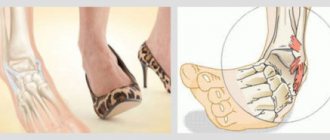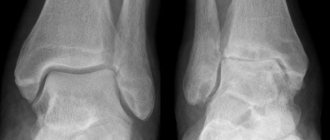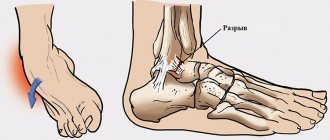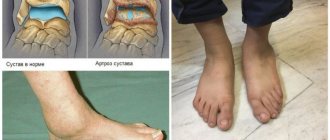An ankle sprain leads to pathological displacement of the bones that form the joint of this part of the leg. Sometimes, when an ankle is fractured, a complete ankle dislocation is diagnosed. Such damage is often associated with a tear, rupture, stretching of ligamentous tissue or subluxation - displacement of part of the surface of the joint.
These injuries often occur due to impact from a fall or walking on a slippery or uneven surface. Symptoms of a sprained ankle include swelling, pain, pathology of support and movement. What to do if your leg is sprained, and how to properly assist the victim?
The essence of the problem
The ankle joint is a system of articular blocks consisting of the tibia, fibula and talus. The mechanism of the injury in question is based on a change in the standard location of the articular surface of one of the bones in relation to each other. A dislocation of the leg in the ankle area can be complete and accompanied by severe consequences, or incomplete, which leads to sprain or damage to the ligaments. Injuries of this kind are accompanied by hidden injuries, but in certain situations they can lead to open fractures.
Talar dislocation means dislocation of the foot in relation to the talus bone in the navicular, calcaneal joint. At the time of injury, the foot may roll inward or outward. When moving inward, the tibial ligaments are injured. An external dislocation causes damage to the peroneal ligaments of the ankle joint.
Rotation of the foot inward or outward during a sprain is quite common.
What causes injury?
Common causes of subluxations include running or walking on uneven terrain, bruising or a strong blow to the foot, wearing high-heeled shoes, and playing sports, especially athletics and football. The ankle is injured as a result of the foot turning inward or outward. Predispose to subluxations and dislocations:
- history of ligamentous-tendon injuries;
- excess weight;
- deforming osteoarthritis;
- inflammatory pathologies of the joint (gout, arthritis of various etiologies);
- flat feet, clubfoot, hallux valgus.
People with congenital ligament weakness often suffer from dislocations and subluxations. Their body produces special, “super-stretchable” collagen - a fibrillar protein, which is the main component of all connective tissues. In such people, due to the increased elasticity of the ligaments, the foot may turn inward even when walking on a flat surface as a result of an awkward, excessively intense movement.
Degrees of ligament damage
The reliability of fixation by the ankle ligaments directly affects the degree of dislocation.
Considering the nature of the injury, the degree of impact on the ligaments, joints and muscles of the leg may vary:
- 1st degree – sprain of the ligament. In reality, sprains do not exist, since they are not elastic formations. Only isolated damage to the fibers, called micro-fractures, is observed. The false concept of “sprain” has come into use over the years, so even representatives of medicine began to use a similar term. This degree of damage is characterized by slight swelling and swelling over the injured ligament; the leg will also hurt after a dislocation. The victim's movements will be moderately limited, but the feeling of support is preserved.
- 2nd degree – tear of the ligament. Rapidly growing swelling of the joint (its inner or outer surface) appears, most often with bruising. The pain becomes more pronounced when moving and continues at rest, it is difficult to move, the feeling of support is unexpressed.
- 3rd degree – ligament rupture. A complete dislocation of the ankle joint leads to rupture of the ligaments. Symptoms characteristic of these cases are represented by visually noticeable displacement of the joint and acute pain. It is impossible to move the foot and move around. The swelling is extensive, affecting both the sole and ankle. A large hematoma appears due to hemorrhage due to poor circulation.
Subluxation due to injury
Often, subluxation of the ankle joint leads to disruption of the integrity of the connective ligaments between the tibia and fibula. These types of injuries are more common in overweight people. Each subsequent ankle dislocation provokes destruction of the cartilage body of the joint, which can lead to arthrosis.
Symptoms and signs of damage
When a sprain occurs, the victim feels only mild pain at the time of injury to the ankle, which quickly disappears. But it may intensify the next day, accompanied by slight swelling of the skin. Severe injuries tend to have more severe symptoms. With dislocation or subluxation, acute pain and a crunching sound occurs, reminiscent of the sound of a dry branch being broken. The intensity of the pain syndrome decreases slightly in the supine position.
Inflammatory edema quickly forms, spreading to the lateral and (or) medial ankle. As soon as it begins to dissolve a little, a blue-violet extensive hematoma immediately forms, gradually descending to the sole. As blood cells break down, the color changes to pale yellow.
Classification of subluxations and dislocations
Leg dislocations in the area under consideration can be classified as follows:
- Internal dislocation occurs when the ankle is fractured on the inside;
- External dislocation occurs when the ankle is fractured on the outside;
- Posterior dislocation - when the back of the tibia is fractured;
- Anterior dislocation is a consequence of joint injury or various fractures of the lower third of the tibia.
The injuries in question can be combined, with a rupture of the tibiofibular syndesmosis, a two- or three-malleolar fracture, a tear and rupture of a large number of ligaments or the joint capsule. Improper treatment of such injuries or delay in going to the hospital can lead to severe impairment of support when walking, constant pain symptoms and the development of arthrosis.
If the injury shows signs of a dislocated leg, you should consult a specialist as soon as possible.
Causes of ankle sprain
The following reasons can lead to a sprained ankle:
- Hit;
- Falling from height;
- Carelessness when turning;
- Incorrect landing on the leg;
- With age, without regular exercise, ligament tissues can weaken;
- The peroneal muscles are underdeveloped from birth;
- High instep;
- A slight sprain of the ligament muscles, received early;
- Disorders of the neuromuscular apparatus of the muscles;
- Gradual weakening of muscles associated with improper walking and foot placement.
The presence of certain diseases can pathologically affect the density of bones and ligaments, increasing the load on the foot.
These diseases include:
- Tuberculosis;
- Diabetes;
- Oncological diseases;
- Obesity;
- Muscle paresis;
- Inflammatory process in tendons and ligaments;
- Pathological processes during intrauterine development.
Symptoms
When a foot is fractured, bruised or dislocated, the symptoms of the injury are quite similar. To exclude a fracture, an x-ray of the injured limb is taken.
When you receive a complex dislocation, it is necessary to correct the damage for the first couple of hours, but without doing anything on your own. Reduction must be performed by a qualified physician.
Among the general signs of foot dislocation in the ankle area, the following pathological symptoms are worth highlighting:
- The area of the foot and ankle swells, and the inflammation increases during the day. The area of leg swelling directly depends on the nature of the injury.
- Discomfortable pain syndrome manifests itself with classic dislocation and with ligament tears of the I or II degree. An open dislocation of the ankle joint with damage to soft tissues provokes acute pain. The discomfort is constantly increasing, palpation is extremely painful.
- Uncomfortable condition and inability to rise to your feet. The third degree results in a lack of control over the foot.
- Symptoms of a sprained leg are also represented by the appearance of an atypical crunch or click when injured.
- The inflammatory process increases the temperature at the site of injury, and occasionally the general temperature.
A tumor in the ankle area is a characteristic symptom of a sprained ankle joint.
Diagnostic methods
A traumatologist can suspect a dislocation or subluxation at the stage of external examination based on characteristic signs - ankle instability, swelling, subcutaneous hemorrhage and pain on palpation. X-rays can exclude or confirm concomitant fractures and avulsions of bone fragments. To assess the condition of ligaments, muscles, cartilage tissue, and blood vessels, ultrasound or MRI is prescribed. The last study is the most informative for determining the surgical field.
First aid
Providing first aid for a sprained leg will minimize the negative consequences:
- If the injury is minor, try to get rid of shoes and socks to normalize blood circulation in the tissues. In particularly severe cases, this should not be done so as not to aggravate the condition.
- Immobilize the limb with a pillow or bolster.
- Apply a cold compress to the injured area to reduce swelling and partially relieve pain symptoms.
- It is important to use analgesics, which are more effective when necessary to relieve severe pain.
After all procedures, you must immediately consult a doctor to assess the severity of the situation, reduce the dislocation, and receive instructions on how to properly treat the dislocated leg.
Anesthesia
Applying cold to the site of the foot dislocation helps prevent further swelling of the affected area, but this measure partially eliminates the pain.
To relieve inflammation and pain symptoms, you can take the following medications of your choice:
- Ibuprofen, Nimesulide, Nise - fight the inflammatory process, relieve swelling;
- Ketanov, Pentalgin, Analgin are powerful anesthetics that suppress pain;
- Troxevasin accelerates the resorption of hematoma.
Reduction of the joint
Any sprained ankle, even a minor injury to the ankle, requires a visit to a qualified podiatrist. The specialist needs to be told in detail about the circumstances of the injury and symptoms. After palpating the lesion, the doctor may prescribe an MRI or radiography to check the integrity of the bone. Reduction of a dislocated joint can be done surgically or manually. In the latter case, the leg pull technique is used. The patient is hospitalized if the dislocation results in a bone fracture. In this case, an operation is performed, which consists of making an incision at the fracture site, realigning the damaged area and fixing the limb with titanium plates or screws.
Treatment at home
For a simple injury, you can treat a sprained ankle at home in consultation with your doctor. Complex treatment involves the use of the following methods.
Cold treatment
Next, we’ll look at how to treat a dislocated foot at home with cold. The course of home cryotherapy treatment lasts for two to three days. Several sessions lasting no more than 15 minutes must be performed daily. Ice can only be applied through a towel or gauze, avoiding direct contact with the skin. Exposure to cold helps slow down metabolic processes by accelerating blood circulation, and also relieves swelling, inflammation and redness.
Applying a tight bandage
At the pharmacy you can purchase a special ankle bandage based on an elastic bandage. In appearance, this bandage resembles a simple sock with a cut off part in the toe area; it will comfortably and securely fix the ankle in the desired position.
If a special cover cannot be found, you can bandage the injured leg yourself using an elastic bandage. The technique consists of applying a bandage from the base of the fingers with a gradual overlap of the previous layer by 3 cm. The bandage is periodically twisted for better fixation. The ends of the bandage are clamped with staples included in the kit.
What to do if you sprain your foot if you don't have an elastic bandage? For fixation, you can get by with a simple bandage. If the injury occurs in the morning, do not bandage the limb too tightly (without interfering with blood circulation), since this bandage cannot be removed all day. At night, the injured limb should rest, so the bandage is removed.
Ointments to relieve swelling
Ointments are used in the treatment of ankle sprains to relieve pain symptoms, resolve hematomas and reduce swelling. Gel products penetrate the skin layer better, so it is better to use them at the beginning of treatment.
The range of creams and ointments is quite large, here are some of them:
- Heparin ointment relieves pain, affects blood vessels, dilating them, which improves blood circulation. The course of treatment is up to 15 days. Analogs are gels based on dexpanthenol or troxerutin - Dolobene-gel, Troxevasin.
- At the initial stages of treatment, you can use Fastum-gel or Bystrumgel, the main active ingredient of which is ketoprofen. These drugs belong to non-steroidal anti-inflammatory drugs, which are characterized by side effects. If treatment is delayed, it is better to replace them with natural analogues: Badyaga, Forte gel, comfrey ointment.
- In the second week of treatment, you can switch to ointments with a warming effect: Finalgon, Efkamon, Apizatron. Their action is aimed at improving metabolism in the connective tissues of the ankle and accelerating the process of ligament restoration.
- Arnica is a homeopathic drug that relieves inflammation and pain. Promotes tissue regeneration and restoration.
Massage
Rehabilitation therapy includes therapeutic massage sessions. Careful circular and longitudinal stroking is carried out in the area of the ankle joint for about two to three minutes. After a couple of minutes, transverse rubbing is performed with the ribs of the palm. Next, each of the ankles is rubbed with the pads of the fingers using longitudinal and spiral movements. Lastly, the arch of the foot is massaged. The whole complex is repeated three times.
Massage of the damaged joint is an integral part of the treatment of dislocation
Compresses and warm baths
To speed up the regeneration process, the following types of compresses are used:
- A herbal compress is made from 3 tablespoons of tansy flowers poured into 200 ml of boiling water, infused for one hour. A bandage soaked in infusion is applied to the site of injury for 2 hours. Analogues of tansy in this recipe can be coltsfoot, celandine or calendula, and chamomile. To relieve pain symptoms, you can alternate between a cold and warm compress.
- A warming compress is made using gauze soaked in medical alcohol. The injured joint is wrapped in a soaked bandage, then wrapped in cellophane and covered with a warm cloth.
- A mixture of two grated potatoes is applied to the ankle overnight and covered with a cotton cloth.
- A compress based on apple cider vinegar is diluted in a ratio of 1:2 and applied to the affected area for 10 minutes.
Among the most effective types of baths, it is worth highlighting the following:
- St. John's wort, coltsfoot, and birch buds are brewed in one liter of boiling water. After the liquid has cooled to 50⁰C, baths are taken before bed every day for a week.
- Ozocerite baths.
- Paraffin-based baths improve blood circulation, speed up the recovery process, and warm up the ligaments.
Treatment of dislocation at home can only be an auxiliary method of therapy
When treating at home, it is important to monitor the level of swelling of the foot. If the swelling does not go away within 4 days after a sprained ankle, you should contact your doctor again. To avoid thrombolism or stroke.
What to do if you have a sprained ankle?
Ankle sprain is a fairly common injury at any time of the year. But with the arrival of spring and an increase in people's activity, as a rule, there is a surge in such injuries.
The ankle joint, along with the knees, supports the entire weight of the body during movement. Therefore, weakening of the ligamentous apparatus and decreased muscle tone, especially with inactivity and excess weight, creates conditions for various injuries, including injuries. Sloppy, sudden movements, incorrect positioning of the foot with overload of one part of the joint, threatens with ankle dislocations.
Damage to the ankle joint, especially with ligament rupture or bone fracture, can lead to quite severe pain, limited mobility and temporary disability.
The most common causes of ankle sprains:
- walking on wet floors, ice or slippery surfaces, leading to falls and joint damage;
- wearing uncomfortable shoes, including high-heeled shoes, platforms, mules;
- movement on uneven surfaces, stones, when there is a high risk of twisting your leg;
- sports, outdoor games with running, jumping;
- professional competitions;
- skeletal pathologies with damage to joints, ligaments and bones, muscles, leading to “loose” joints and gait instability;
- lesions of the nervous system, in which coordination and stability when walking suffer, a person places his foot incorrectly on the floor.
Damage to the joint occurs if the foot turns sharply inward or outward during movement. Then the external or lateral ligaments are overloaded, the bones of the joint are displaced relative to each other. In parallel with a dislocation, ligament sprains or ruptures, as well as bone fractures, are possible.
Symptoms of a sprained ankle:
- severe, acute pain that occurs immediately after the injury - it intensifies when trying to move the foot;
- increasing swelling of the tissues at the site of injury, especially pronounced in the lower part of the leg, the junction of the foot - due to swelling and pain, it is almost impossible to step on the leg and walk;
- When blood vessels rupture, a hematoma can form and the skin becomes bluish.
With ankle subluxation, the symptoms are not as pronounced as with dislocation and rupture of the ligament. Pain and discomfort are especially pronounced when walking; they may subside with rest. The joint is swollen, deformed, foot movements are limited, the skin has a normal color.
Treatment of a sprained ankle
If, after an injury (fall, twisted leg), pain and swelling occur, or a cracking or crunching sound is heard, you should immediately go to the emergency room. It is necessary to determine the severity of the damage to the joint and exclude bone fractures, which will be important for the treatment of a sprained ankle. Self-medication for this type of injury threatens subsequent instability of the ligaments and repeated injuries at the slightest damage and the development of osteoarthritis of the joint (a chronic inflammatory lesion with the destruction of cartilage and bones).
1. Diagnostics
If you suspect a sprained ankle, you need to go to the emergency room and/or make an appointment with a traumatologist-orthopedist at the Canon clinic.
The first stage is to clarify the circumstances of the injury and examine the doctor, during which he will find out where the most severe pain is localized, how limited the movement of the foot is, and what additional complaints the patient has. The traumatologist will assess the amount of swelling, the presence of bruises or hematomas, and the position of the foot.
An X-ray of the affected joint is required to rule out bone fractures. In order not to miss possible damage, x-rays are taken in two projections, this makes it possible to assess the condition of the tibia and fibula, the outer and inner ankle.
2. Modern methods of treatment
After making a diagnosis, the doctor administers anesthesia to reduce the dislocation and apply a fixing bandage. If a bone fracture, joint deformity or bone displacement is confirmed, after restoring the correct structure of the joint, the doctor fixes the foot in the correct position with a plaster cast.
If this is a dislocation of the ankle without a fracture, the doctor will apply a U-shaped plaster splint (from the toes, along the bottom of the foot, covering the heel and upper third of the leg) for a period of 12 - 14 days. If the injury is more serious, the entire foot and lower leg are cast for up to 3 to 5 weeks.
To reduce pain and inflammation for the first 3 to 4 days, it is recommended to take non-steroidal anti-inflammatory drugs (in tablets or capsules). They reduce pain, swelling, and discomfort in the affected area.
After removing the bandage, physical therapy and massage of the limb are prescribed, gradually increasing the load on the foot to help restore the functions of damaged joint tissues, ligaments, and improve blood circulation. When walking for the first time, you should not overload the joint; it is possible to walk with a badik. Additionally, a course of physical therapy may be recommended, especially in old age when the healing process is slower.
It is important to choose comfortable and non-slip shoes to prevent re-injury during the first weeks after removing the bandage or plaster, which can seriously damage the tissues of the joint.
Prevention of ankle sprains
There are a number of tips that can help prevent serious leg injuries, including the ankle joint. To prevent ankle sprains, before any sports activities, a warm-up is necessary, a series of warm-up exercises that increase blood flow to the joints and improve the elasticity of the ligaments.
It is important to move carefully on wet floors or slippery surfaces, holding onto objects and handrails. It is necessary to select the most comfortable shoes without heels or with a stable thick heel no higher than 3 - 4 cm and a hard heel.
You should avoid walking on rough terrain where there is gravel or stones, and do not exercise on treadmills covered with pebbles or steep mountain paths.
When it comes to preventing re-injury, at first it is important to use special fixing orthoses with elastic bandages. The doctor will show you how to properly bandage damaged joints.
Rehabilitation for a sprained ankle
In the first 24 - 48 hours after injury, any warming procedures are contraindicated; rubbing, compresses, ointments. Do not take a hot bath or drink alcohol. Since all this dilates the blood vessels and will inevitably lead to an increase in edema. If you did everything correctly and it became easier, it is still better to see a doctor and undergo additional tests - x-rays, ultrasound to rule out more serious damage.
With this type of damage, it is enough to wear a fixing 8-shaped bandage made of an elastic bandage for 10 - 14 days or, for convenience, an elastic bandage; it is recommended to remove the bandage at night. Non-steroidal anti-inflammatory ointments and gels (Dolobene, Artrosilene, Indovazin) are used locally.
Also, in a complex of rehabilitation measures, you can use a modern and well-proven method - kinesio taping. Depending on the application method, it can be used both in the acute period to reduce swelling, and in a later period to accelerate the recovery of ligaments and stabilize the ankle joint.
Pain and swelling usually go away within the first 10 to 14 days. But complete restoration of the ligaments occurs no earlier than 4 - 6 weeks. Therefore, during this time it is recommended to avoid excessive physical activity (running, jumping, dancing, etc.), and ideally undergo a course of physical rehabilitation in order to restore the biomechanics of movement not only of the foot, but of the entire body.
First aid for a sprained ankle:
1. It is necessary to exclude any load and movement in the ankle joint in the first hours, or preferably a day after the injury.
2. Give the limb an elevated position, at an angle of 15 - 30 ° - any pillows that you have at home are suitable for this.
3. Apply cold to the area of maximum pain and swelling. This could be a piece of meat from the freezer, a bag of frozen berries, etc. It must first be wrapped in cloth. To prevent tissue frostbite, the exposure time is no more than 10 minutes, then a 10-15 minute break and repeat this 3 times.
4. Apply an 8-shaped fixing bandage, you can use a regular bandage, but preferably an elastic bandage. The main thing is not to overdo it: the bandage should not increase pain, cause numbness or coldness of the fingers.
Questions and answers
Questions about the treatment of injuries and diseases of the musculoskeletal system that interest you, you can ask the head doctor of the Canon clinic, orthopedist-traumatologist, candidate of medical sciences Leonid Kurzov weekly on Fridays from 10.00 a.m. until 12.00
Recovery period
When an ankle sprains, the recovery time depends on the level of professionalism of the doctor and competently provided first aid. You should also not lose attention to such factors as the physiological characteristics of the body, the correctness of the prescribed treatment, and the effectiveness of physical therapy.
During the recovery period, it is recommended to adhere to the following rules:
- For microtraumas, dislocations and subluxations, it is mandatory to use an elastic bandage for two weeks. On days 5-7 the swelling decreases, and after 10 days the mobility of the limb is gradually restored. The period of complete therapy ranges from 10 to 15 days.
- If the ligaments were not damaged, after reduction a plaster cast is applied for 15 days. In parallel, during this period, special rehabilitation exercises are performed. The recovery period takes 1-1.5 months.
- In case of complete dislocation with displacement of the joint, if surgery was performed, you can prepare for discharge only after 5-7 days. Until the bone heals completely, the injured limb is kept in a cast for 20 days. With this diagnosis, the treatment period lasts from 1.5 to 2 months.
The presence of an elastic bandage on the damaged joint is mandatory
First aid for sprains and subluxations of the ankle joint
Doctors advise athletes to use the so-called RICE therapy. RICE is an acronym for the English words Rest, Ice, Compression and Elevation.
Rest is rest: even with a mild ankle sprain, a break from physical activity is necessary.
Ice is ice that should be applied to the injured area to relieve pain, reduce swelling and bruising, and stimulate circulation.
Compression is compression. Immediately after cooling with ice, the injured ankle must be carefully wrapped with an elastic bandage from the toes to the middle of the shin. This will prevent swelling and bruising, and also reduce joint mobility, thereby preventing more severe damage.
Elevation is raising your leg up. This is like a fracture: try to keep your leg above the level of your heart to reduce the spread of swelling and hematoma.
Prevention measures
As a preventative measure, you can perform a number of strengthening exercises:
- Walking barefoot on small pebbles or sand.
- Daily walking training on the inside and outside of the foot.
- Calf muscle training. The exercise is as follows: place the toe of the foot on any elevated support so that the heel hangs slightly. With smooth movements you need to lower and raise your heel on your toe.
- Jumping rope will strengthen not only the ankle joint, but also the hands.
- A good practice would be to collect scattered small objects (coins, buttons, stones) on the floor with your toes.
- For sedentary work, you can roll a small water bottle or light dumbbells with your bare feet.
Remember, if all signs point to a sprained ankle, do not wait for the injury to go away on its own, otherwise the ligaments and tendons may not heal properly and the foot will become unstable due to deformities
. Reducing a dislocation in a hospital will not take much time, and thanks to qualified assistance, the functionality of the leg will be restored much faster.











